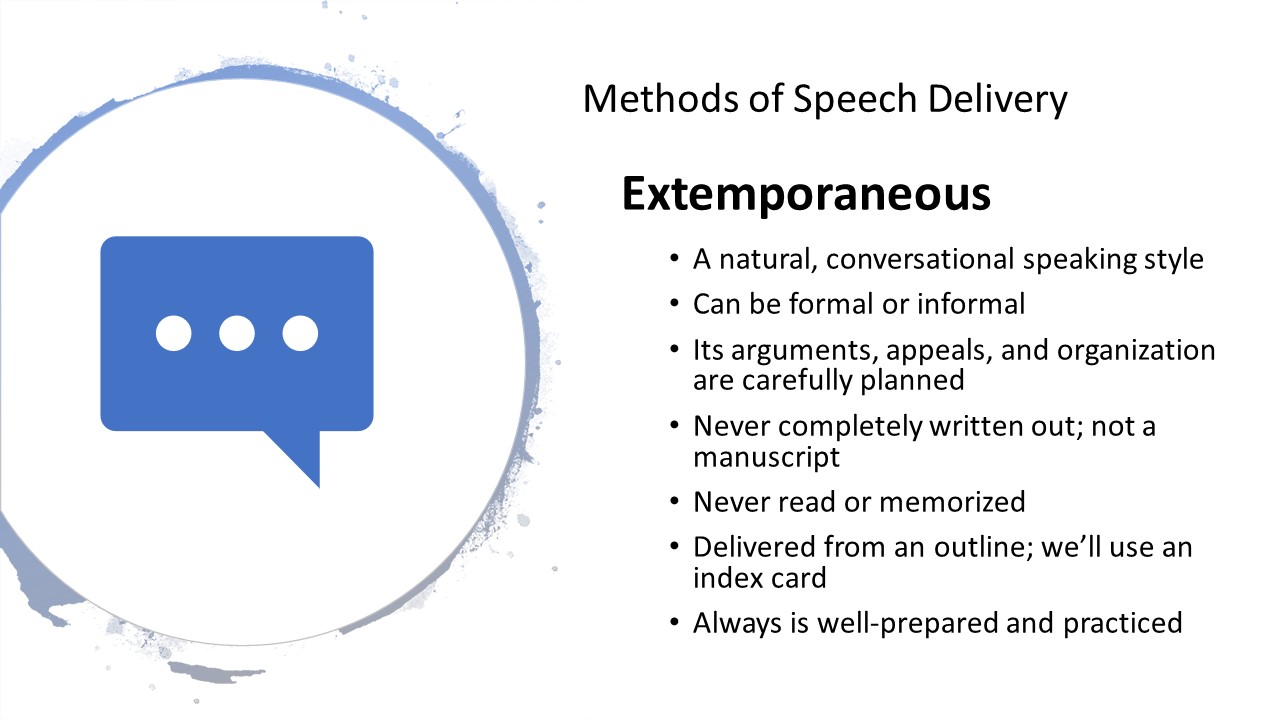What Are The Characteristics Of An Extemporaneous Speech?
Are you curious about extemporaneous speeches? Wondering what makes them unique? Well, you’ve come to the right place! In this article, we’ll explore the characteristics of an extemporaneous speech and why it’s such an interesting form of public speaking. So, let’s dive in and unravel the secrets of extemporaneous speaking together!
When it comes to extemporaneous speeches, there are a few key characteristics that set them apart. First and foremost, extemporaneous speeches are delivered without relying on a prepared script. Instead, speakers rely on their knowledge and experience to deliver the speech in a spontaneous and engaging manner. It’s like having a conversation with the audience, making it more interactive and dynamic!
Not only are extemporaneous speeches unscripted, but they also allow speakers to think on their feet. This means that they have to quickly gather their thoughts, organize their ideas, and deliver them coherently in real-time. It’s like a mental challenge that builds critical thinking skills and helps speakers become more adaptable and confident on stage. So, if you’re up for a thrilling speaking adventure, extemporaneous speeches might be just the thing for you!

The Characteristics of an Extemporaneous Speech: A Guide to Effective Public Speaking
Welcome to our comprehensive guide on the characteristics of an extemporaneous speech. In this article, we will explore the key elements that make an extemporaneous speech unique and effective. Whether you are a student, a professional, or someone looking to improve their public speaking skills, understanding the characteristics of an extemporaneous speech will help you deliver impactful and engaging presentations.
1. Spontaneity and Preparation:
An extemporaneous speech is characterized by a balance between spontaneity and preparation. Unlike impromptu speeches, which are completely unprepared, an extemporaneous speech requires some level of preparation beforehand. However, it also allows for flexibility and adaptation in the moment. The speaker should have a clear outline or structure for the speech but should not rely on a script word for word. This allows for a more natural and conversational delivery.
During the preparation phase, speakers research and gather information on the topic, organize their thoughts, and create an outline. This ensures that they have a solid foundation to build upon during the actual speech. It also helps them to anticipate questions or challenges that may arise during the presentation. However, the actual delivery of the speech should feel spontaneous and authentic, as if the speaker is speaking naturally without reading from a script.
Benefits:
– Allows for adaptability and responsiveness to the audience
– Creates a more engaging and authentic connection with the audience
– Provides a balance between structure and flexibility
2. Knowledge and Expertise:
An extemporaneous speech requires the speaker to have a deep understanding and knowledge of the topic they are speaking about. This is different from a memorized speech where the speaker may have simply memorized a script without truly understanding the content. In an extemporaneous speech, the speaker should be able to share their knowledge, opinions, and insights on the topic, demonstrating their expertise and credibility.
To develop this expertise, it is essential for the speaker to conduct thorough research and stay informed about the latest developments in the field. This allows them to provide relevant and up-to-date information to the audience. It is also important for the speaker to practice critical thinking and analysis, so they can effectively interpret and communicate complex ideas. The combination of knowledge and expertise contributes to the speaker’s credibility and enhances the overall impact of the speech.
Tips:
– Stay informed about the latest news and developments in the topic area
– Practice critical thinking and analysis to deepen your understanding of the subject
– Use personal anecdotes or examples to illustrate your points and enhance relatability
3. Engaging Delivery:
The delivery of an extemporaneous speech should be engaging and captivating. The speaker should strive to connect with the audience and hold their attention throughout the presentation. This can be achieved through various techniques such as eye contact, body language, vocal variety, and storytelling. Eye contact helps to establish a connection with the audience and convey sincerity and confidence. Body language, including gestures and facial expressions, can enhance the speaker’s message and make it more expressive.
Vocal variety involves using different tones, pitches, and pauses to maintain the audience’s interest and emphasize key points. Finally, incorporating storytelling or personal anecdotes can make the speech more relatable and memorable. A well-delivered extemporaneous speech should feel conversational and natural, as if the speaker is having a meaningful conversation with the audience.
Tips:
– Practice your delivery to ensure a confident and natural speaking style
– Use visual aids or props to enhance engagement and understanding
– Incorporate humor or personal experiences to connect with the audience
4. Effective Time Management:
A characteristic of an extemporaneous speech is the ability to effectively manage time. The speaker should have a good sense of timing and be able to deliver the speech within the allocated time frame. This requires careful planning and rehearsal to ensure that all the key points are covered without going over the allotted time. Effective time management also allows for more audience engagement, as the speaker can allocate sufficient time for questions or interactive activities.
One way to manage time effectively is by practicing the speech multiple times and timing yourself. This helps to identify areas where you might be spending too much time or where you need to pace yourself. It is also important to prioritize the most important points and content, so that even if time is limited, you can convey the essential information to the audience.
Tips:
– Practice your speech multiple times to get a sense of timing
– Use a timer during rehearsals to ensure you stay within the allocated time
– Prioritize the most important points to ensure they are covered even if time is limited
5. Audience Engagement and Interaction:
An extemporaneous speech aims to actively engage the audience and foster interaction. This can be achieved through various techniques such as asking questions, encouraging participation, and incorporating interactive activities. By involving the audience in the speech, the speaker creates a more dynamic and memorable experience. It also helps to capture and maintain the audience’s attention throughout the presentation.
Incorporating interactive elements, such as group discussions, brainstorming sessions, or Q&A segments, allows the audience to actively participate and contribute to the speech. This not only encourages engagement but also provides an opportunity for the speaker to address any questions or concerns the audience may have. By tailoring the speech to the specific needs and interests of the audience, the speaker can create a more meaningful and impactful experience.
Tips:
– Ask open-ended questions to encourage audience participation
– Incorporate interactive activities such as group discussions or case studies
– Use visual aids or props to enhance engagement and understanding
6. Adapting to Different Contexts:
Extemporaneous speaking requires the ability to adapt to different contexts and audiences. The speaker should be able to adjust their language, tone, and style to suit the specific audience they are addressing. This could mean using simpler language and avoiding technical jargon when speaking to a general audience or adjusting the level of formality based on the setting.
Adapting to different contexts also involves considering cultural sensitivities and being aware of the specific circumstances in which the speech is being delivered. This allows the speaker to connect with the audience on a deeper level and ensure that the message resonates effectively.
Tips:
– Research the audience beforehand to understand their expectations and preferences
– Avoid using overly technical language or jargon that the audience may not understand
– Consider cultural sensitivities and adapt your speech to the specific context
7. Confidence and Authenticity:
In an extemporaneous speech, confidence and authenticity play a crucial role. The speaker should project confidence in their knowledge and delivery, which helps to establish trust and credibility with the audience. Confidence can be enhanced through thorough preparation, practice, and a belief in one’s own abilities.
At the same time, the speaker should strive to be authentic and genuine in their delivery. Audiences appreciate speakers who are real and transparent, as it creates a stronger connection and makes the message more relatable. Being yourself, sharing personal stories or experiences, and expressing your genuine passion for the topic can contribute to a more impactful and authentic speech.
Tips:
– Practice your speech to build confidence in your delivery
– Be genuine and true to yourself in your presentation style
– Share personal anecdotes or experiences to enhance authenticity
Benefits of Extemporaneous Speaking:
Extemporaneous speaking offers several benefits, both in professional and personal contexts. Let’s explore some of the key advantages:
1. Enhanced Communication Skills:
Practicing extemporaneous speaking improves your overall communication skills. It helps you develop the ability to think on your feet, respond quickly, and organize your thoughts effectively. This can be particularly beneficial in professional settings where clear and concise communication is essential.
2. Improved Critical Thinking:
When delivering an extemporaneous speech, you must engage in critical thinking to analyze and interpret the topic. This enhances your ability to process information, form coherent arguments, and present them persuasively. Improved critical thinking skills can have a positive impact on both your professional and personal life.
3. Build Confidence:
Extemporaneous speaking allows you to build confidence in your speaking abilities. The more you practice and deliver extemporaneous speeches, the more comfortable and self-assured you will become. This newfound confidence can translate into improved performance in various aspects of your life.
4. Adaptability and Flexibility:
Extemporaneous speaking prepares you to adapt and be flexible in different situations. It teaches you how to think quickly, adjust your message based on audience feedback, and overcome unexpected challenges. These skills are valuable in today’s fast-paced and ever-changing world.
5. Engaging and Memorable Presentations:
An extemporaneous speech, when delivered effectively, captures and maintains the audience’s attention. The spontaneity, authentic delivery, and audience interaction create a memorable presentation that resonates with the listeners. This can help you make a lasting impact and leave a positive impression.
Public Speaking Tips:
Whether you are preparing for an extemporaneous speech or any other type of presentation, the following tips can help you improve your public speaking skills:
1. Practice, Practice, Practice:
Rehearse your speech multiple times to build familiarity and confidence. Practice in front of a mirror, record yourself, or deliver the speech to friends or family for feedback. The more you practice, the more comfortable you will feel during the actual presentation.
2. Know Your Audience:
Research your audience to understand their background, interests, and expectations. Tailor your speech accordingly to ensure it resonates with the listeners and meets their specific needs. Adapting your message to the audience can greatly enhance its impact.
3. Use Visual Aids:
Visual aids such as slides, props, or infographics can enhance the audience’s understanding and engagement. Use visual aids sparingly and ensure they complement your speech rather than distract from it. Prepare them in advance and rehearse their incorporation into your presentation.
4. Seek Feedback:
Solicit feedback from trusted individuals or mentors who can provide constructive criticism. Analyze their feedback and identify areas for improvement. Incorporate their suggestions into your practice sessions to refine your speech and delivery.
5. Stay Calm and Manage Nervousness:
Feeling nervous before a speech is natural, but it’s important to manage your nervousness. Take deep breaths, visualize a successful presentation, and remind yourself of your preparation. Channel your nervous energy into enthusiasm and excitement for sharing your knowledge and insights with the audience.
6. Use Humor:
Incorporating humor into your speech can help to engage the audience and create a more entertaining experience. Use appropriate jokes or light-hearted anecdotes to effectively connect with the listeners. However, be mindful of cultural sensitivities and avoid offensive or divisive humor.
7. Reflect and Learn:
After delivering a speech, take time to reflect on your performance. Identify your strengths and areas for improvement. Learn from your experiences and continue to refine your public speaking skills with each opportunity.
By incorporating these tips and understanding the characteristics of an extemporaneous speech, you can become a more confident and effective public speaker. Remember to focus on authenticity, audience engagement, and the development of your communication skills. With practice and dedication, you can deliver compelling and impactful speeches that leave a lasting impression.
Key Takeaways: Characteristics of an Extemporaneous Speech
- An extemporaneous speech is delivered without prior memorization or complete script.
- It requires the speaker to have good knowledge on the topic and be able to think on their feet.
- It is characterized by a conversational tone, allowing for a natural and spontaneous delivery.
- Extemporaneous speeches often involve the use of notes or speaking prompts to guide the speaker.
- They allow for flexibility and adaptability, as the speaker can adjust their content and delivery in real time.
Frequently Asked Questions
Extemporaneous speeches are a unique form of public speaking where the speaker presents a speech without extensive preparation. These speeches are characterized by their ability to be delivered with little to no time for practice or rehearsal. Here are some commonly asked questions about the characteristics of an extemporaneous speech:
1. How is an extemporaneous speech different from other types of speeches?
An extemporaneous speech differs from other types of speeches, such as impromptu or scripted speeches, in that it strikes a balance between preparation and spontaneity. Unlike impromptu speeches where the speaker has no time to prepare, extemporaneous speeches allow for some prior knowledge and research, but without the use of a complete script. The speaker is expected to deliver the speech in a conversational manner while maintaining the attention of the audience.
In an extemporaneous speech, the speaker must rely on their knowledge of the topic, their ability to think on their feet, and their skill in organizing their thoughts quickly. This allows for a more natural and engaging delivery that captures the interest of the audience.
2. What are the key characteristics of an extemporaneous speech?
The key characteristics of an extemporaneous speech include spontaneity, flexibility, and organization. Since extemporaneous speeches are delivered with minimal preparation, the speaker needs to be able to think quickly and adapt their speech to fit the situation or audience. The use of notes or an outline is common in extemporaneous speeches to help the speaker stay on track and remember key points, but they should not rely heavily on a script.
Additionally, extemporaneous speeches should have a clear and logical structure, with an introduction, body, and conclusion. The speaker should be able to present their ideas in a coherent manner, using transitions and examples to support their main points. It is also important for the speaker to maintain eye contact with the audience and use body language to enhance their message.
3. How can one effectively prepare for an extemporaneous speech?
Effective preparation for an extemporaneous speech involves familiarizing oneself with the topic at hand and developing a solid understanding of the key points and supporting details. This can be done through research, reading, and keeping up-to-date with current events. The speaker can also practice organizing their thoughts quickly and creating a mental outline of the speech.
Furthermore, it is essential to practice impromptu speaking in order to develop the ability to think on one’s feet. Engaging in activities such as participating in debates or joining a public speaking club can help enhance these skills. Additionally, practicing under time constraints can simulate the pressure of delivering an extemporaneous speech and help the speaker become more comfortable with the format.
4. What are the benefits of delivering an extemporaneous speech?
Delivering an extemporaneous speech offers several benefits for both the speaker and the audience. For the speaker, it provides an opportunity to enhance communication skills, critical thinking abilities, and the ability to respond to unexpected situations. By practicing extemporaneous speaking, individuals can improve their ability to think quickly, articulate their thoughts clearly, and engage with an audience in a genuine and impactful way.
For the audience, extemporaneous speeches are often more engaging and relatable compared to speeches that are heavily scripted or memorized. The presenter’s natural delivery and ability to adapt to the audience’s reactions can create a sense of authenticity and connection. Extemporaneous speeches also tend to feel more conversational, allowing the audience to feel more involved in the discussion.
5. How can one overcome the challenges of delivering an extemporaneous speech?
Overcoming the challenges of delivering an extemporaneous speech requires practice, confidence, and preparation. Practicing impromptu speaking regularly can help individuals become more comfortable with thinking on their feet and speaking extemporaneously. Building confidence in one’s knowledge of the topic and ability to adapt can also help in overcoming anxiety or fear about delivering an unprepared speech.
Another helpful strategy is to embrace the moment and view extemporaneous speaking as an opportunity rather than a challenge. Recognize that mistakes or pauses are natural and can even add authenticity to the speech. Trust in one’s ability to communicate effectively and engage with the audience, and remember that the primary goal is to deliver a meaningful message rather than achieving perfection.

What is Extemporaneous Speaking?
Summary
An extemporaneous speech is a speech given without much preparation or written script. It requires the speaker to think on their feet and speak confidently.
Extemporaneous speeches should have a clear introduction, body, and conclusion. It is important to organize thoughts and use simple language that is easy for the audience to understand. Good eye contact, gestures, and a confident tone are also key to delivering an effective extemporaneous speech.



